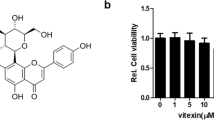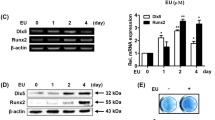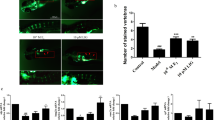Abstract
Amentoflavone is a bioflavonoid found in a variety of traditional Chinese medicines such as Gingko and Selaginella tamariscina. It has been reported that amentoflavone has anti-inflammatory, antioxidant, antiviral and anticancer effects. However, the effect of amentoflavone on osteogenic differentiation of human mesenchymal stem cells (hMSCs) has not been studied. In this study, we aim to explore the effect of amentoflavone on the proliferation and osteogenic differentiation of hMSCs. The results showed that amentoflavone significantly enhanced the proliferation, alkaline phosphatase (ALP) activity and mineralization in hMSCs. Western blot analysis revealed that the expression of runt-related transcription factor 2 and osterix proteins was upregulated in amentoflavone-treated hMSCs. Furthermore, we investigated the possible signaling pathways responsible for osteogenic differentiation of hMSCs by amentoflavone. We found that amentoflavone significantly increased the levels of phosphorylated JNK and p-p38. The amentoflavone-induced increases of ALP and mineralization were significantly diminished when the JNK and p38 MAPK pathways were blocked by selected inhibitors (SP600125, SB203580) in hMSCs. Furthermore, in vivo evidence indicated that amentoflavone protected against the dexamethasone-induced inhibition of osteoblast differentiation in tg(sp7:egfp) zebrafish larvae. Thus, we showed for the first time that amentoflavone improves the osteogenesis of hMSCs through the JNK and p38 MAPK pathway. Amentoflavone may be beneficial in treating bone-related disorders.









Similar content being viewed by others
References
Raisz LG (2005) Pathogenesis of osteoporosis: concepts, conflicts, and prospects. J Clin Investig 115:3318–3325
Rachner TD, Khosla S, Hofbauer LC (2011) Osteoporosis: now and the future. Lancet 377:1276–1287
Marie PJ, Kassem M (2011) Osteoblasts in osteoporosis: past, emerging, and future anabolic targets. Eur J Endocrinol 165:1–10
Sandhu SK, Hampson G (2011) The pathogenesis, diagnosis, investigation and management of osteoporosis. J Clin Pathol 64:1042–1050
Suthon S, Jaroenporn S, Charoenphandhu N, Suntornsaratoon P, Malaivijitnond S (2016) Anti-osteoporotic effects of Pueraria candollei var. mirifica on bone mineral density and histomorphometry in estrogen-deficient rats. J Nat Med 70:225–233
Pittenger MF, Mackay AM, Beck SC, Jaiswal RK, Douglas R, Mosca JD, Moorman MA, Simonetti DW, Craig S, Marshak DR (1999) Multilineage potential of adult human mesenchymal stem cells. Science 284:143–147
Jiang YH, Jahagirdar BN, Reinhardt RL, Schwartz RE, Keene CD, Ortiz-Gonzalez XR, Reyes M, Lenvik T, Lund T, Blackstad M, Du J, Aldrich S, Lisberg A, Low WC, Largaespada DA, Verfaillie CM (2002) Pluripotency of mesenchymal stem cells derived from adult marrow. Nature 418:41–49
Deans RJ, Moseley AB (2000) Mesenchymal stem cells: biology and potential clinical uses. Exp Hematol 28:875–884
Wang X, Wang Y, Gou W, Lu Q, Peng J, Lu S (2013) Role of mesenchymal stem cells in bone regeneration and fracture repair: a review. Int Orthop 37:2491–2498
Cao L, Liu G, Gan Y, Fan Q, Yang F, Zhang X, Tang T, Dai K (2012) The use of autologous enriched bone marrow MSCs to enhance osteoporotic bone defect repair in long-term estrogen deficient goats. Biomaterials 33:5076–5084
Shekkeris AS, Jaiswal PK, Khan WS (2012) Clinical applications of mesenchymal stem cells in the treatment of fracture non-union and bone defects. Curr Stem Cell Res Ther 7:127–133
Park WW, Suh KT, Kim JI, Kim SJ, Lee JS (2009) Decreased osteogenic differentiation of mesenchymal stem cells and reduced bone mineral density in patients with adolescent idiopathic scoliosis. Eur Spine J 18:1920–1926
Pino AM, Rosen CJ, Rodriguez JP (2012) In osteoporosis, differentiation of mesenchymal stem cells (MSCs) improves bone marrow adipogenesis. Biol Res 45:279–287
DeLaurier A, Eames BF, Blanco-Sanchez B, Peng G, He X, Swartz ME, Ullmann B, Westerfield M, Kimmel CB (2010) Zebrafish sp7:EGFP: a transgenic for studying otic vesicle formation, skeletogenesis, and bone regeneration. Genesis 48:505–511
Fleming A, Sato M, Goldsmith P (2005) High-throughput in vivo screening for bone anabolic compounds with zebrafish. J Biomol Screen 10:823–831
De Vrieze E, Van Kessel MA, Peters HM, Spanings FA, Flik G, Metz JR (2014) Prednisolone induces osteoporosis-like phenotype in regenerating zebrafish scales. Osteoporos Int 25:567–578
Luo S, Yang Y, Chen J, Zhong Z, Huang H, Zhang J, Cui L (2016) Tanshinol stimulates bone formation and attenuates dexamethasone-induced inhibition of osteogenesis in larval zebrafish. J Orthop Transl 4:35–45
Lin YM, Anderson H, Flavin MT, Pai YH, Mata-Greenwood E, Pengsuparp T, Pezzuto JM, Schinazi RF, Hughes SH, Chen FC (1997) In vitro anti-HIV activity of biflavonoids isolated from Rhus succedanea and Garcinia multiflora. J Nat Prod 60:884–888
Zhang Z, Sun T, Niu JG, He ZQ, Liu Y, Wang F (2015) Amentoflavone protects hippocampal neurons: anti-inflammatory, antioxidative, and antiapoptotic effects. Neural Regen Res 10:1125–1133
Park NH, Lee CW, Bae JH, Na YJ (2011) Protective effects of amentoflavone on Lamin A-dependent UVB-induced nuclear aberration in normal human fibroblasts. Bioorg Med Chem Lett 21:6482–6484
Tarallo V, Lepore L, Marcellini M, Dal Piaz F, Tudisco L, Ponticelli S, Lund FW, Roepstorff P, Orlandi A, Pisano C, De Tommasi N, De Falco S (2011) The biflavonoid amentoflavone inhibits neovascularization preventing the activity of proangiogenic vascular endothelial growth factors. J Biol Chem 286:19641–19651
Weaver CM, Alekel DL, Ward WE, Ronis MJ (2012) Flavonoid intake and bone health. J Nutr Gerontol Geriatr 31:239–253
Xu D, Xu L, Zhou C, Lee WY, Wu T, Cui L, Li G (2014) Salvianolic acid B promotes osteogenesis of human mesenchymal stem cells through activating ERK signaling pathway. Int J Biochem Cell Biol 51:1–9
Greenblatt MB, Shim JH, Zou W, Sitara D, Schweitzer M, Hu D, Lotinun S, Sano Y, Baron R, Park JM, Arthur S, Xie M, Schneider MD, Zhai B, Gygi S, Davis R, Glimcher LH (2010) The p38 MAPK pathway is essential for skeletogenesis and bone homeostasis in mice. J Clin Investig 120:2457–2473
Kwon HS, Johnson TV, Tomarev SI (2013) Myocilin stimulates osteogenic differentiation of mesenchymal stem cells through mitogen-activated protein kinase signaling. J Biol Chem 288:16882–16894
Harrison G, Shapiro IM, Golub EE (1995) The phosphatidylinositol-glycolipid anchor on alkaline phosphatase facilitates mineralization initiation in vitro. J Bone Miner Res 10:568–573
Orimo H, Shimada T (2008) The role of tissue-nonspecific alkaline phosphatase in the phosphate-induced activation of alkaline phosphatase and mineralization in SaOS-2 human osteoblast-like cells. Mol Cell Biochem 315:51–60
Komori T, Yagi H, Nomura S, Yamaguchi A, Sasaki K, Deguchi K, Shimizu Y, Bronson RT, Gao YH, Inada M, Sato M, Okamoto R, Kitamura Y, Yoshiki S, Kishimoto T (1997) Targeted disruption of Cbfa1 results in a complete lack of bone formation owing to maturational arrest of osteoblasts. Cell 89:755–764
Fakhry M, Hamade E, Badran B, Buchet R, Magne D (2013) Molecular mechanisms of mesenchymal stem cell differentiation towards osteoblasts. World J Stem Cells 5:136–148
Nishio Y, Dong Y, Paris M, O’Keefe RJ, Schwarz EM, Drissi H (2006) Runx2-mediated regulation of the zinc finger Osterix/Sp7 gene. Gene 372:62–67
Liao QC, Xiao ZS, Qin YF, Zhou HH (2007) Genistein stimulates osteoblastic differentiation via p38 MAPK–Cbfa1 pathway in bone marrow culture. Acta Pharmacol Sin 28:1597–1602
Metscher BD, Ahlberg PE (1999) Zebrafish in context: uses of a laboratory model in comparative studies. Dev Biol 210:1–14
Trede NS, Langenau DM, Traver D, Look AT, Zon LI (2004) The use of zebrafish to understand immunity. Immunity 20:367–379
Amatruda JF, Shepard JL, Stern HM, Zon LI (2002) Zebrafish as a cancer model system. Cancer Cell 1:229–231
Dooley K, Zon LI (2000) Zebrafish: a model system for the study of human disease. Curr Opin Genet Dev 10:252–256
Du SJ, Frenkel V, Kindschi G, Zohar Y (2001) Visualizing normal and defective bone development in zebrafish embryos using the fluorescent chromophore calcein. Dev Biol 238:239–246
Kim SN, Bae SJ, Kwak HB, Min YK, Jung SH, Kim CH, Kim SH (2012) In vitro and in vivo osteogenic activity of licochalcone A. Amino Acids 42:1455–1465
Pasqualetti S, Banfi G, Mariotti M (2012) The zebrafish scale as model to study the bone mineralization process. J Mol Histol 43:589–595
Acknowledgments
This project was supported by the National Natural Science Foundation of China (30772768, 81102450), Science and Technology Planning Project of Guangdong Province (2013B031800013), Natural Science Foundation of Guangdong Province (2014A030313534), Administration of Traditional Chinese Medicine of Guangdong Province (20151263), Social Science and Technology Development Project of Dongguan (2014108101052), Science and Technology Planning Project for Medical Treatment and Public Health of Dongguan (2014105101294) and Initiating Fund of Scientific Research for Doctors of Guangdong Medical University (B2013016).
Author information
Authors and Affiliations
Corresponding authors
Ethics declarations
Conflict of interest
The authors declare no conflict of interest.
Additional information
X. Zha and Z. Xu contributed equally.
Rights and permissions
About this article
Cite this article
Zha, X., Xu, Z., Liu, Y. et al. Amentoflavone enhances osteogenesis of human mesenchymal stem cells through JNK and p38 MAPK pathways. J Nat Med 70, 634–644 (2016). https://doi.org/10.1007/s11418-016-0993-1
Received:
Accepted:
Published:
Issue Date:
DOI: https://doi.org/10.1007/s11418-016-0993-1




